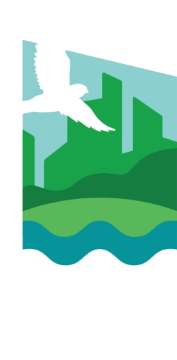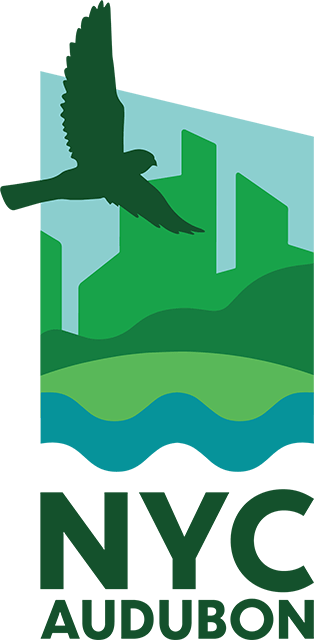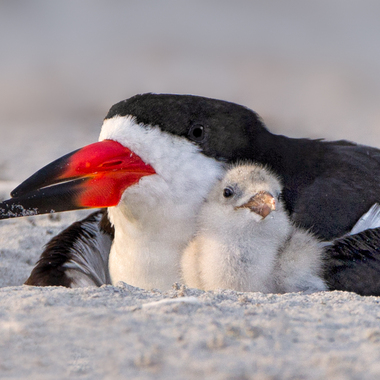
Black Skimmers nest on several beaches on the Rockaway Peninsula, in Queens. Photo: David Speiser
Beach Nesting Birds
Each year, from April through August, thousands of birds nest on the bare sands of New York City beaches and inlets. Common and Least Terns, Black Skimmers, American Oystercatchers, and Piping Plovers—all of these species come to our city beaches to breed, as they have for millennia. The birds lay their eggs in shallow scrapes in the sand, sometimes lined with bits of shell and debris, placed above the high tide line in open, sandy areas with little to no vegetation. The eggs and chicks are perfectly camouflaged to match their sandy environment. Downy chicks that look like tiny fluff balls leave their nests soon after hatching—but stay on the beach for several weeks, learning from their parents, until they are old enough to fly and survive on their own.
Unfortunately, today these birds are competing for highly prized real estate. Nesting on the open beach is a challenge under the best of circumstances—weather can be harsh, predators roam, and storms or extreme tides can harm nests. When human beings vie for the same limited space and do not actively protect the vulnerable birds and their young, successful nesting can become impossible.
Beach-nesting birds are extremely sensitive to human disturbance. Eggs and chicks are camouflaged to resemble the sand and can easily be stepped on or run over and crushed. The birds see humans and their pets as predators; when a human or dog wanders too close to nesting sites, the adult birds leave the nest, exposing the eggs or chicks to extreme temperatures and predation by gulls and crows. Continued disturbance can lead to nest abandonment. And the trash humans leave behind does a lot of damage as well: garbage attracts animals such as gulls, foxes, and raccoons, which readily prey on beach-nesting birds and their young.
Several species of beach-nesting birds have shown alarming population declines in recent years. The Atlantic population of Piping Plover is federally Threatened, having declined to less than 2,000 pairs. The Black Skimmer population has declined by 87 percent since 1966, and now nests in only 3 colonies in New York State. (Learn more about the status of these species, as well as the Common Tern and American Oystercatcher, below.) Observed declines in the populations of beach-nesting bird species are all the more worrisome, as coastal nesting habitat is itself being gradually diminished by the rising sea levels of our warming world.
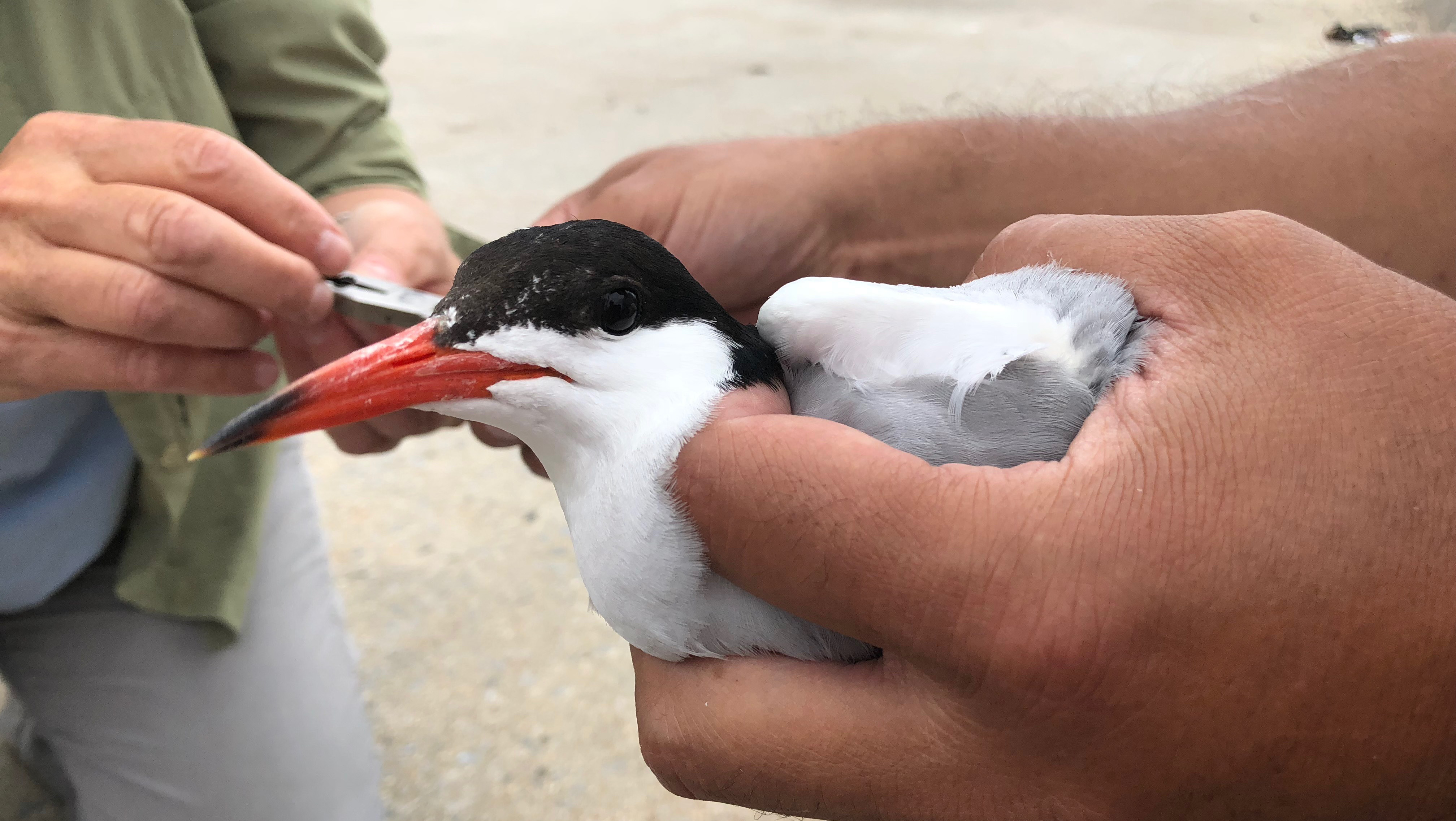 "}" data-trix-content-type="undefined" class="attachment attachment--content">
"}" data-trix-content-type="undefined" class="attachment attachment--content">Monitoring, Banding Research, and Outreach
NYC Audubon monitors several local populations of beach-nesting waterbirds in order to better understand declines in their populations, and to provide a sound scientific grounding as we advocate for further protections for them. We also conduct research using banding and migration tracking technologies to better understand both local and long-distance movements of these species. Read about our banding work in the species profiles below.
We use our research and expertise to inform local communities about the threats posed to vulnerable beach-nesting birds through our Share the Shore campaign. Through in-person events, messaging at beaches, and social media, Share the Shore unites the voices of scientists, birders, and beachgoers to help others learn about these birds and become engaged as their protectors. Learn more about our Share the Shore outreach.
We use our research and expertise to inform local communities about the threats posed to vulnerable beach-nesting birds through our Share the Shore campaign. Through in-person events, messaging at beaches, and social media, Share the Shore unites the voices of scientists, birders, and beachgoers to help others learn about these birds and become engaged as their protectors. Learn more about our Share the Shore outreach.
Get to Know the Beach-nesting Birds!
Click on each species below to see more photos and learn more.
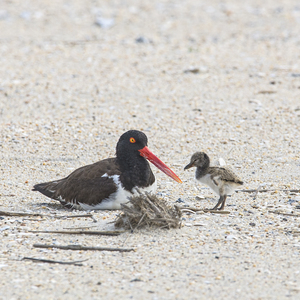
An American Oystercatcher adult and chick. Photo: KatVitulano Photos/CC BY-ND 2.0
American Oystercatcher

American Oystercatcher (Haematopus palliates)
Overview: The American Oystercatcher is hard to miss. This large, black-and-white shorebird with a glowing orange bill, orange-and-yellow eye, and hysterical laugh of a call seems a bit like a cartoon bird. This impression is heightened during breeding season, when oystercatcher pairs perform synchronized mating and territorial displays on our local beaches. True to its name, this charismatic species, endemic to the Americas, is a specialized feeder on saltwater bivalve mollusks, and lives almost exclusively in coastal habitat from Nova Scotia to Tierra del Fuego. “Our” breeding oystercatchers migrate south for the winter, though some may stick around if the weather is mild.
Where They Nest in NYC: The majority of the City’s American Oystercatchers nest in Brooklyn and Queens, around Jamaica Bay—on the beaches of the Rockaways, where NYC Audubon monitors their nesting activity, and on beaches and islands within the Bay. Smaller populations have also been confirmed nesting along Staten Island’s South Shore and in the Bronx’s Pelham Bay Park.
Nesting Details: One look at the nest of the American Oystercatcher explains why these beach-nesting birds can be imperiled by careless humans: it consists of a shallow depression in the bare sand, sometimes lined with bits of shell or pebbles, in which the female typically lays three camouflaged eggs. Oystercatchers typically begin arriving back in our area in March, and pairs may establish territories several weeks before laying eggs; young usually fledge in July.
Conservation Status: While the American Oystercatcher is currently not considered a species of conservation concern in New York State, the species is on the Partners in Flight’s Yellow Watch List because of its narrow habitat preference and limited range. According to American Bird Conservancy, the species’ total population is estimated to be only 43,000 individuals. The low total population of the American Oystercatcher in North America (approximately 10,000 individuals) has led to its listing as a Species of High Concern in the U.S. Shorebird Conservation Plan. Nesting oystercatchers are vulnerable to disturbance by humans and predators, development of its coastal habitat, and rising sea levels.
NYC Audubon Conservation Work: Since 2012, NYC Audubon has been monitoring, tracking, and assessing habitat disturbance of American Oystercatchers that nest on the Rockaway peninsula. Our field biologists monitor pairs of nesting American Oystercatchers at Breezy Point, Fort Tilden, and Jacob Riis Park throughout the breeding season to track productivity and identify causes of nest failure. By banding adult birds throughout the City (in partnership with the National Park Service and New York City Parks Wildlife Unit) we can track these long-lived birds over the years, following their patterns of territory choice and nest success. Banding chicks allows us to monitor survival and dispersal. To date, the NYC Audubon science team has banded 46 adults and 68 chicks, some of which have since been spotted with chicks of their own, breeding in New Jersey and Connecticut.

An American Oystercatcher adult and chick. Photo: KatVitulano Photos/CC BY-ND 2.0
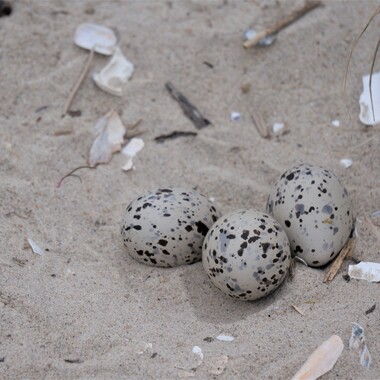
An American Oystercatcher pair’s nest is a minimal affair, closely watched over by the parents. Photo: Lloyd Spitalnik
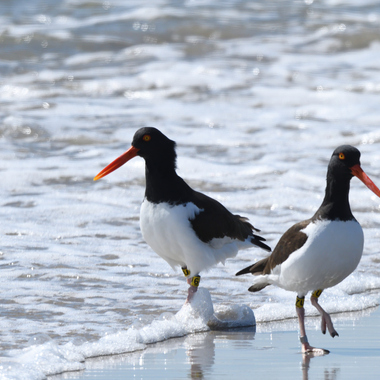
American Oystercatcher breeding pair “6U and 7U,” banded in 2013, have fledged eight young as of spring 2019. Photo: NYC Audubon
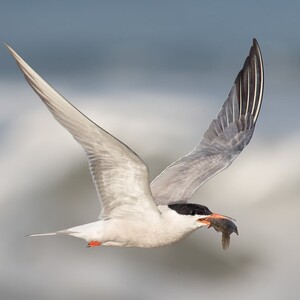
A parent Common Tern brings food back to the nesting colony. (Notice the dark coloring of the upper surface of the primaries, which helps distinguish this species from the silvery-winged Forster’s Tern.). Photo: David Speiser
Common Tern

Common Tern (Sterna hirundo)
Overview: Common Terns are indeed common, at least compared to other North American terns: the species has a global range, nesting on coastal and inland areas across a wide band of the Northern Hemisphere and wintering in coastal areas throughout the Southern Hemisphere. Like all terns, this graceful, primarily fish-eating seabird is a sharply shaped creature, with pointed bill, wings, and tail. During breeding season, its black cap and white and gray coloring can make it tricky to distinguish from the similar Forster’s Tern; Common Terns have darker red bills and feet, a darker upper surface to their primaries, and slightly shorter tails, usually not protruding beyond the wing tips.
Where They Nest in NYC: Common Terns nest on several beaches of the Rockaways, on marsh islands around Jamaica Bay, in the Bronx’s Pelham Bay Park, on the South Shore of Staten Island, and on several decommissioned piers on the southeast end of Governors Island (since 2008).
Nesting Details: Common Terns nest in closely packed colonies that sometimes consist of many thousands of individuals; in large colonies, the birds can be aggressive in defense of their colony, divebombing intruders. Colonies are often placed among low-growing beach plants, which afford some protection for the chicks. Beach nests consist of shallow scrapes in the sand lined with shell and bone fragments and beach debris, in which the female normally lays 2-3 eggs. In New York City, the species typically begin nesting in May; young usually fledge by mid to late July.
Conservation Status: Though the Common Tern’s North American population is stable according to the North American Breeding Bird Survey, the species is listed as Threatened in New York State. Common Terns have a relatively stable population on most of the Atlantic Coast but appear to be declining in New York and states to the south. The species’ numbers have recovered since it was nearly extirpated along the Eastern Seaboard in the 19th Century, As was the case with egrets, terns were hunted to adorn ladies’ hats (which in the tern’s case, often featured an entire bird).
NYC Audubon Conservation Work: NYC Audubon has monitored the Governors Island Common Tern colony since 2013. On two occasions, in 2014 and 2017, we have enhanced pier nesting sites with oyster shells and/or grasses and structures designed to exclude gulls from nest sites. Both enhancements were followed by an increased number of successful nesting pairs at those sites in following years. In addition to leg bands, in recent years we have used radio-tracking and light-level geolocators to examine local and long-distance movements of birds from the Governors Island colony.
Read more about Common Terns on the New York State Department of Environmental Conservation website.

A parent Common Tern brings food back to the nesting colony. (Notice the dark coloring of the upper surface of the primaries, which helps distinguish this species from the silvery-winged Forster’s Tern.). Photo: David Speiser
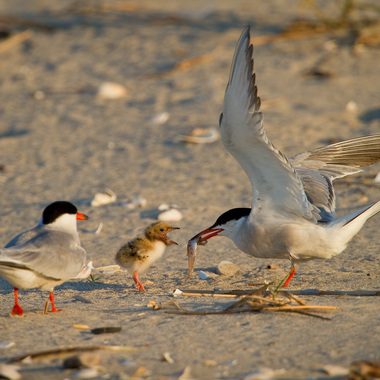
Common Terns nest on several beaches of the Rockaways, on marsh islands around Jamaica Bay, in the Bronx’s Pelham Bay Park, on the South Shore of Staten Island, and on several decommissioned piers on the southeast end of Governors Island. Photo: François Portmann
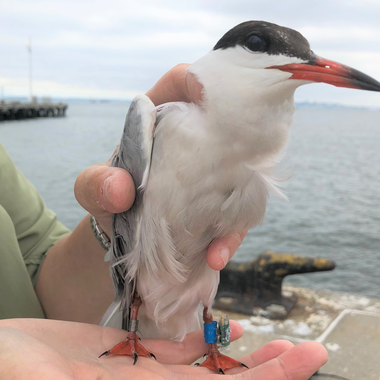
A banded adult Common Tern on Governors Island; the geolocator tag is visible on the bird’s left leg. Photo: NYC Audubon
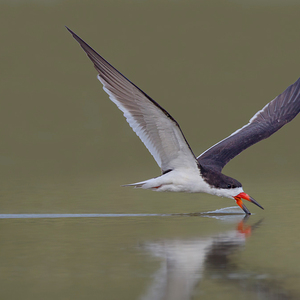
The Black Skimmer’s long lower bill slices through the water; when it touches a fish, the upper mandible snaps shut in a split-second reflex. Photo: David Speiser
Black Skimmer

Black Skimmer (Rynchops niger)
Overview: The unmistakable Black Skimmer is one of those birds that make us aware just how different birds are from humans. When a skimmer flock appears over the surf, their long wings just grazing the water and their massive orange underbills neatly etching neat grooves in the surface, we indeed feel visited by avian dinosaurs—which of course all birds are. Endemic to the Americas, the Black Skimmer visits New York City only during the summer. In North America it lives exclusively on the coasts, but is a resident across the South American continent, “skimming” for fish on the Amazon River and inland lakes. Because Skimmers catch fish by touch—their upper mandible snaps shut when the lower bill contacts prey—they are able to feed in low light and are largely crepuscular, or even nocturnal.
Where They Nest in NYC: In recent years, Black Skimmers have nested at two beaches on the Rockaway Peninsula, in Arverne and Breezy Point, Queens.
Nesting Details: Black Skimmers nest in colonies, in our area usually in the company of Common Terns, which may afford their chicks some protection from predators1. Beach nests are simple scrapes in the sand, in which the female normally lays 1-5 eggs. (When on the nest or resting, Skimmers lie flat, resting their large bills on the ground.) In New York City, the species is the latest of our beach-nesting birds to arrive and nest. Skimmers arrive in May and usually lay eggs in May and June; young usually fledge by mid to late August, though the breeding season may be longer if the birds re-nest. In recent years, our skimmers have sometimes abandoned their first attempt and moved, perhaps due to disturbance.
Conservation Status: Black Skimmer numbers have dropped considerably in the last 50 years: according to the North American Breeding Bird Survey, their population declined 87% between 1966 and 2015. In New York State, Black Skimmers now nest in only three colonies, one of which is in New York City (the other two being located further east on Long Island’s South Shore). The reduction in number of colonies and close proximity of the colonies results in a high risk of colony failure or abandonment due to weather, human disturbance, or predation. A single storm or overwash event could all but eliminate the breeding population in New York State.
NYC Audubon Conservation Work: We collaborate with the NYC Parks Wildlife Unit and New York State Department of Environmental Conservation to band Black Skimmer chicks in the New York City nesting colonies each year. These data contribute to collaborative research on the status and decline of Black Skimmers in New York State. In early 2020 NYC Audubon provided a summary of the current status of the Black Skimmer in New York along with the request that the species be upgraded to “Endangered” status in New York State.
Read more about Black Skimmers on the New York State Department of Environmental Conservation website.

The Black Skimmer’s long lower bill slices through the water; when it touches a fish, the upper mandible snaps shut in a split-second reflex. Photo: David Speiser
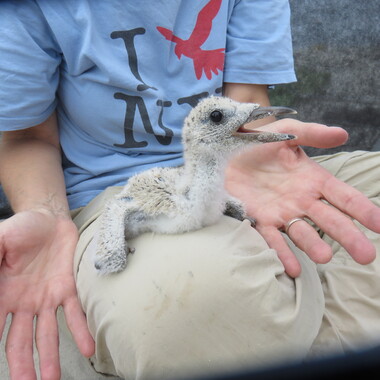
NYC Audubon collaborates with the NYC Parks Wildlife Unit and New York State Department of Environmental Conservation to band Black Skimmer chicks in the New York City nesting colonies each year. In early 2020 NYC Audubon provided a summary of the current status of the Black Skimmer in New York along with the request that the species be upgraded to “Endangered” status in New York State. Photo: NYC Audubon
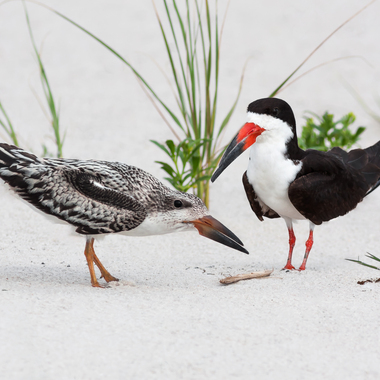
Black Skimmers have abandoned their colonies on the Rockaway Peninsula several times in recent years, possibly due to disturbance by human beach-goers. Photo: Ellen Michaels
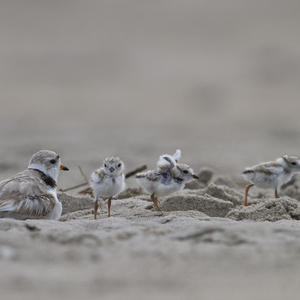
The Piping Plovers of the Atlantic Coast are listed as Threatened federally, and Endangered (the highest threat level, meaning in danger of extinction) in New York State. According to Partners in Flight, the global breeding population of this species consists of only 8,400 individual birds. Photo: François Portmann
Piping Plover

Piping Plover (Charadrius melodus)
Overview: The Piping Plover has become the symbol of threatened beach-nesting birds, perhaps both due to its dwindling numbers and because, to use scientific terminology: it is unbelievably cute! This small, rotund sandpiper is divided into two subspecies that breed in different regions—Atlantic and Prairie. While research on the species’ wintering grounds is ongoing, “our” breeding birds are believed to winter primarily along the southeastern coast of the U.S. Piping Plovers feed on invertebrates they find on beaches and mudflats.
Where They Nest in NYC: In New York City, Piping Plovers nest exclusively on the beaches of the Rockaway Peninsula, in Queens.
Nesting Details: Nests consist of a shallow depression in the sand, sometimes lined with bits of shell or pebbles, in which the female typically lays four camouflaged eggs. Piping Plovers often nest near clumps of grass and/or colonies of Common or Least Terns and American Oystercatchers. In New York City, the species typically arrives in March and lays eggs in May and June; young usually fledge in July.
Conservation Status: The Piping Plovers of the Atlantic Coast are listed as Threatened federally, and Endangered (the highest threat level, meaning in danger of extinction) in New York State. According to Partners in Flight, the global breeding population of this species consists of only 8,400 individual birds.
NYC Audubon Conservation Work: New York City’s Piping Plovers are monitored and managed by city and federal agencies. NYC Audubon contributes to protecting plovers through our Share the Shore outreach program and our advocacy for strengthened protections for all beach-nesting birds.
Read more about Piping Plovers on the City of New York’s WildlifeNYC website and the New York State Department of Environmental Conservation website.

The Piping Plovers of the Atlantic Coast are listed as Threatened federally, and Endangered (the highest threat level, meaning in danger of extinction) in New York State. According to Partners in Flight, the global breeding population of this species consists of only 8,400 individual birds. Photo: François Portmann
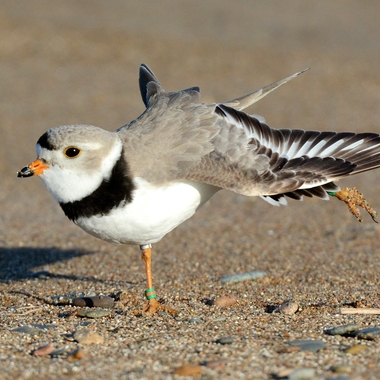
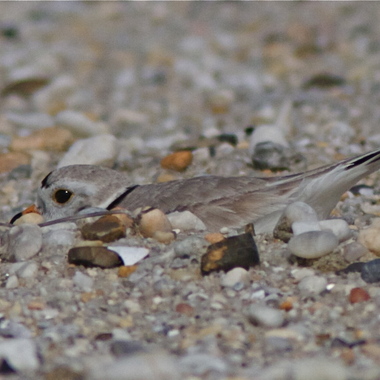
A very well camouflaged adult Piping Plover, sitting tight on its nest. Photo: Henry T. McLin/CC BY-NC-ND 2.0
Citations and Additional Resources
1) Gochfeld, M. (1978b). Colony and nest site selection by Black Skimmers. Proc. Colonial Waterbird Group 1:78-90.
Additional Sources for “Get to Know the Birds”
New York Breeding Bird Atlas III eBird data courtesy of Cornell Lab of Ornithology, Ithaca, NY, USA.
Sauer, J. R., D. K. Niven, J. E. Hines, D. J. Ziolkowski, Jr, K. L. Pardieck, J. E. Fallon, and W. A. Link. 2017. The North American Breeding Bird Survey, Results and Analysis 1966 - 2015. Version 2.07.2017 USGS Patuxent Wildlife Research Center, Laurel, MD
